Now that the Skirvin is a done deal, what's next downtown? Doug Dawgz crystal balls don't work but this post explores a couple of obscure downtown buildings, one of which is pretty ancient (1926-27), one less so (1957), but both having similar original names ... The Petroleum Building and the Petroleum Club Building. One of them has the potential to become much more than it presently is.
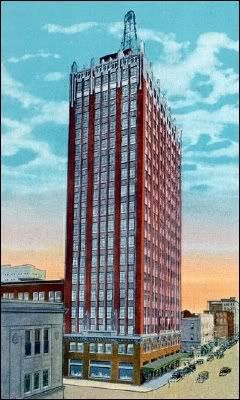
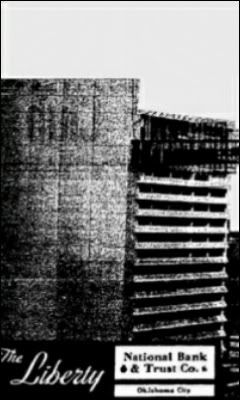
Quick Look. The Petroleum Building (above left) was built in 1926-27. Its 18 stories made it the tallest building downtown and so it remained until 1931 when the Ramsey Tower and 1st National Bank were completed. The 16 story Petroleum Club Building, above right, located immediately east of and flush against the 1964 expansion by Kerr-McGee of the Petroleum Building, opened in 1957. Built by Liberty Bank when Liberty was located in the present-day City Place Building, it was connected to Liberty by a skywalk, the 1st in the city. It provided parking, office space, and housed its namesake Petroleum Club. But, to most Oklahoma Citians, both buildings are probably obscure today – the Petroleum Building is now called the Dowell Center, looks different, and is largely unoccupied. The Petroleum Building is now, as far as I can tell, a "building with no name" and most people probably think of it as nothing more than a parking garage. It's exterior only shows its address, 120 Robert S. Kerr. This post explores the history of both "Petroleum" buildings.
The Petroleum Building. Construction began in 1926 and was done in 1927 during one of Oklahoma City's "boom" building periods. Once finished, it was the tallest structure in Oklahoma City at 18 stories. An Oklahoman article (8/21/1927) gushed over the new $750,000 home for those involved in the oil business, including its imported Italian and Vermont marble and terra cotta trim, and high speed (700 feet per minute) micro-leveling elevators, said to have been the 1st such elevators in the state. "If utility had been the only end desired, more than $75,000 could have been deducted from the $750,000 construction cost," the Oklahoman article said. A large (48 to 50 feet – reports vary) oil derrick illuminated by colored lights sat on top of the building, and, according to Edwards & Ottaways' Vanished Splendor (Abalache Book Shop Publishing Co. 1982), it could be seen for 15 miles.
The "tallest building" moniker didn't last long – in 1931, the Ramsey Tower and 1st National Bank were finished, each having 31 stories and relegating it to third place height-wise. Click the images below for a larger view.
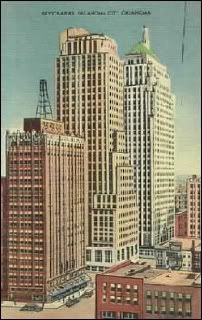
A photo within the 8/29/87 Oklahoman article by Bob Blackburn:
"City's Architecture Still Has Character"
(Sorry about the grainy image – I'll replace it when I find one better)
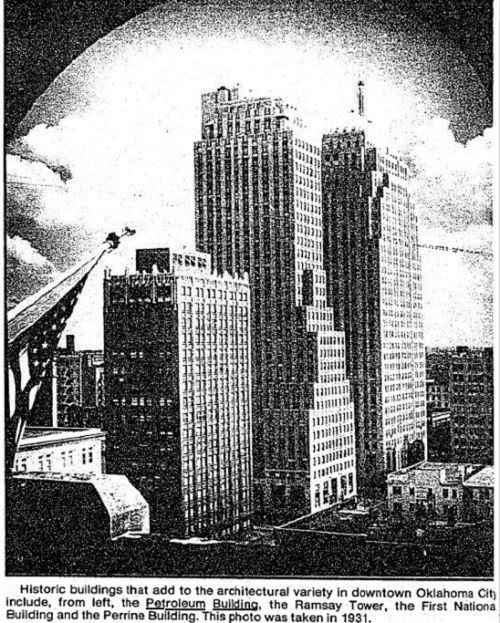
Whether the Petroleum Building couldn't match its new next-door neighbors' competition, or because of the effects of the 1929 Wall Street crash and the Great Depression, or for some other reason, a federal court mortgage foreclosure was filed in March 1933 which resulted in an ownership change in 1934. 1934 also appears to have been the year that the oil derrick was dismantled for safety reasons.
Cravens Corporation became the owner in 1946, the same year it acquired the Perrine Building (now Robinson Renaissance). On July 2, 1947, a three-alarm fire in a vacant hotel/apartment building licked the building, but it escaped injury. Click the pic below for a larger image.
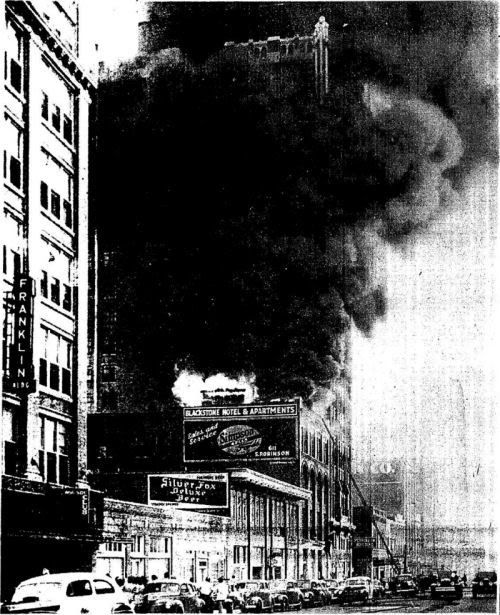
Another anecdotal Oklahoman story: A business executive jumped from the building and leaped to his death in 1949 as shoppers watched. See the Oklahoman archives, 2/17/1949, front page.
What's the deal with this building – is it snake-bit or something?
After the Cravens Corporation acquired the property, the Oklahoman's renditions about the building's ownership appear to be inconsistent. A November 26, 1952, article said that controlling interest in the property was acquired from Cravens by principals in the Kerr-McGee Corporation (e.g., Sen. Robert S. Kerr, Dean A. McGee and others) in 1952, but a September 5, 1971, article says that Republic Supply Company purchased it in 1952 and that Kerr-McGee got it in 1962. If you really want to figure out the "blur", go to the County Courthouse and check out the County Clerk's deed records and that should tell the tale. I'm presently satisfied to accept the blur as non-consequential.
In any event, in 1964, Kerr-McGee completely remodeled the property – stripped it to its core, doubled the east/west depth, and added 2 stories to make it 20 stories tall – and renamed the new building as the Kermac Building, the new headquarters of Kerr-McGee.
I don't have a decent picture contemporaneous with the $4 million 1964 remodeling, but it should look much the same as those shown under "The Building Today," below, since the exterior hasn't changed since that time. A 4/19/1964 article in the Oklahoman describes the changes:
"A building was knocked out that separated the Republic Building [ed note: aka Petroleum Building] from the Petroleum Club Building to the east, and a new structure was erected.Kerr-McGee's 1964 remodeling/expansion of the building was apparently a work of art at the time – but, not known then were the effects of asbestos, a large factor leading to the building's present emptiness, and it was during the 1964 remodeling that asbestos was added to the building.
Exterior differences were reconciled with a new front of gray-tinted glass in aluminum frames, and interiors of the Republic building were refurbished to mold with the new design for a single structure integrating the old with the new. * * *
Walls and columns of the lobby are ceramic tile and opalescent granite. Vinyl wall covering, anodized aluminum and stainless steel provide harmonizing patterns in the color scheme.
A major portion of the ceiling is white acoustical plaster. The floor is slate at entrances and precast terrazzo tile in the main lobby."
A March 1, 1964, Oklahoman article boldly declared, "Capital City Has A New Downtown!", citing this structure as an example. "Downtown Oklahoma City is being renewed – slowly but definitely – without waiting for Urban Renewal." As well, this came at the time of the announcement of the 24 story Regency Tower at NW 5th and Hudson – and even then speculation existed that a downtown supermarket or lesser grocery store would be needed which, of course, has still not occurred these 33 years later! Other developments were cited – the 12 story Holiday Inn on West Main, remodeling of the Biltmore by Sheraton-Oklahoma, and of the Huckins and Skirvin. The 10 story Southwestern Bell building at NW 6th and Robinson (now owned by the Department of Environmental Quality) and the new Federal Courthouse had also occurred.
But, of course, Kerr-McGee continued to prosper and, in 1973, its fine Kerr-McGee Center opened. In 1971, the Kermac Building aka Republic Building was sold to Midland Mortgage Company and it became the Midland Center (to this date, the name shown on the County Assessor's rolls as the building name, despite its current ownership). In 1980, Prudential Realty Group, part of Prudential Insurance Company of America, acquired the property. A 3/19/1992 Oklahoman article quoted Barbara Simpkins, then the building's manager, as saying, in 1986, "the building was so full of tenants that we were literally renting janitorial closet space." Prudential had plans to remodel the building, including asbestos removal, but in 1988 that company decided to dispose of such assets nationwide, and the planned remodeling (including asbestos removal) did not occur.
In 1988, it sold the property to B&P Midland Center, Ltd., a Dallas investment firm. A 6/2/1988 Oklahoman article described the transaction and noted that, "Present occupancy is about 50 percent." From that 50%, it went down from there. A March 19, 1992, Oklahoman article announced that, as of June 1, the top (19 of 20) floors of the building would be "mothballed" because of the asbestos issues associated with remodeling for tenants, among other issues (e.g., heating/air conditioning was controlled by one control from the 3rd floor up!). Remodeling would also require the installation of a sprinkler system, which would require asbestos removal, which would require millions of dollars.
And, so it has remained as we fast forward to 2007. In 1995, the property was acquired by Dowell Properties, LLC, (the developer and owner "Midtown Plaza" on Walker and the "Dowell Center Parking" on Harvey east of the Federal Courthouse) and it became known as the Dowell Center, and things haven't changed ... yet.
But, is there light at the end of the tunnel? A January 16, 2007, "For Public Comment" article at the Okc's Planning Commission website notes that, "Dowell Properties, LLC has applied for a cleanup loan from the City of Oklahoma City's Brownfields Cleanup Revolving Loan Fund (BCRLF) for abatement of asbestos in the 20-story Dowell Center * * *. Asbestos abatement is required prior to the owner's intended renovation of the building's interior. * * * The City of Oklahoma City is accepting public comments on the ABCA through February 15, 2007."
An analysis is included in the 11 page document, and it notes that, "The overall project includes the complete interior renovation of the basement, east half of the first floor, floor 3 and floors 12 through 20, completely renovating these floors into new office, commercial retail, and mechanical equipment space. Abatement of the elevator shaft and elevator equipment room is also included in the project."
Will this happen? We'll just have to wait and see. If it does happen, will Rick Dowell's company revitalize this project into a building that our city will be proud of, once again? We'll just have to wait and see. Doug Dawg is skeptical ... the Dowell Parking Garage on Harvey is certainly nothing to write home about nor is the Midtown Plaza (that said, the development is certainly better than the nothing that was there before), but Doug Dawg would like to be proven wrong! I'll certainly be among the many to congratulate Rick Dowell for leading the Petroleum Building/aka Dowell Center into the 21st Century with a revitalized building which occupies all of its 20 floors into an attractive and good place for prospective tenants to be, now and in the future. Free parking at the Dowell Parking Garage on Harvey (many blocks away) as a tenant-inducement ain't gonna cut it, though, and the parking space at the next-door neighbor "Petroleum Club" building is already spoken for. Tenants paying all their utility expenses on top of their per square foot lease contracts for their rented premises ain't, either, as I see it. As I said, we'll just have to wait and see. Doug Dawg is presently pessimistically optimistic!
The Building Today. For now, have a look at the Dowell Center at 134 Robert S. Kerr. Some don't seem to like this building's looks, but I'm not one of them. In my opinion, it's a nice piece of Oklahoma City's diversity and, but for the asbestos, Kerr-McGee did a nice job in changing the original Petroleum Building into this ... click on any image for a larger view.

Looking Northeast From Robinson
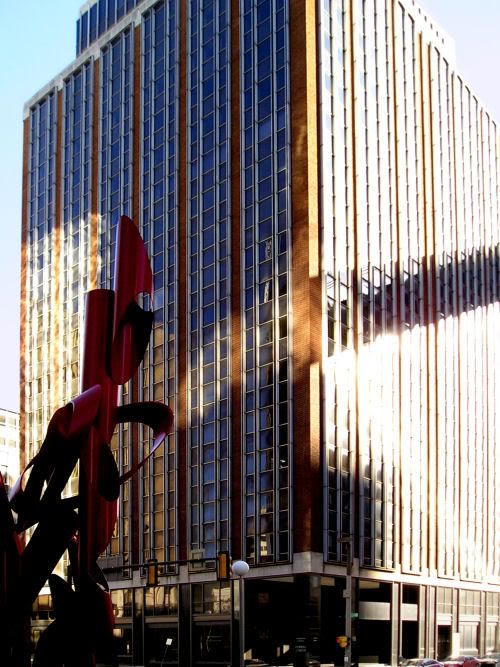
Looking Northeast From Robinson – A Closer View
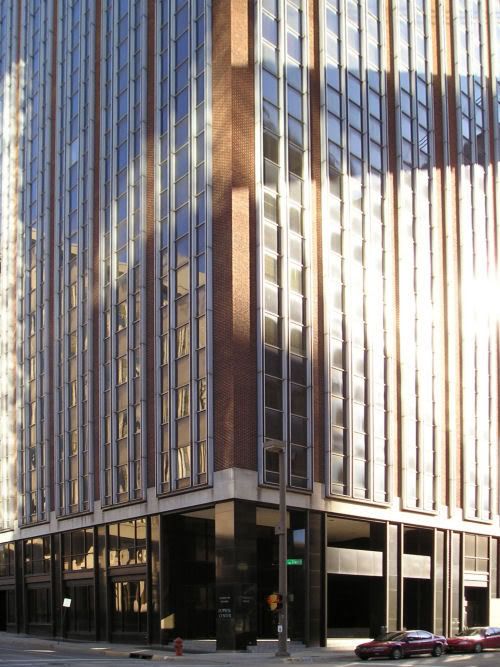
Looking East Along Couch Drive
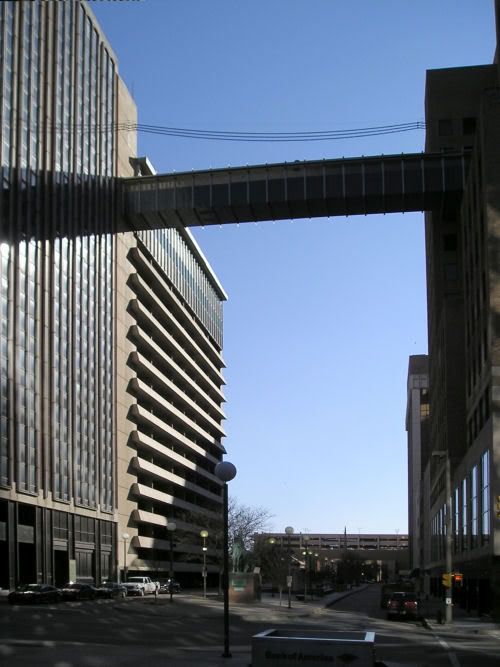
Looking Northwest Along Couch Drive

The Petroleum Club Building. The 16 story Petroleum Club was built by Liberty National Bank and opened at 120 Robert S. Kerr on September 1, 1957, the public announcement occurring in a splashy Oklahoman ad on March 20, 1956. A March 11, 1956, story in the Oklahoman informs that the building was named for its prominent new tenant, the newly formed Oklahoma City Petroleum Club which would occupy the 15th floor. By November 1956, it was decided to double its size to two floors, adding the 14th. The original tenant of the 16th floor was Magnolia Petroleum Company. A combination parking garage and office space building, stories said that it would accommodate 500 cars which would be moved into the building by a mechanical elevating parking system.
Originally, Liberty planned to ask the City for permission to connect the new building to its parent Liberty National Bank (now the City Place Building) with a tunnel underneath Couch Drive but that apparently got changed since a 14th floor skywalk (the 1st in the city) connecting to the 15th floor of the Liberty Bank building was constructed, instead. The lower level would also be used for automated drive-through tellers for Liberty's banking customers. A September 1, 1957, Oklahoman article described the car elevator system: "The new garage will utilize the Bowser elevator system for parking cars, eliminating the use of turning ramps between floors. Moving either sideways, diagonally or straight up and down, the elevator deposits a car in a parking stall on any floor with a minimum of driving."
When the Liberty Bank Tower opened in 1971, the building lost its name and its principal tenant, the Petroleum Club, to the new Liberty downtown tower, then the tallest building in the state. Although Liberty Bank no longer exits, the swank Petroleum Club does, occupying the 34th, 35th, and 36th floors of the currently named Chase Tower.
Several years back, early 1990s if memory serves, when I officed in City Place, the skywalk led to the offices of the Sonic Corporation. Of course, it later moved to the 101 Park Avenue Building and then to its current building in Bricktown.
Today, both City Place and the former Petroleum Club Building are owned by Globe Life and Accident Insurance Company, and my understanding is that Globe Life is the principal tenant in the former Petroleum Club Building, but I'm not certain of that.
I tried hard to find some good juicy stories about the building in the Oklahoman's archives, but I came up pretty empty-handed.
It occurred to me to think that the end-of-the-Prohibition period would be a good place to look into since Cannonball Joe was in full swing in the 1st quarter of 1959 and the Petroleum Club opened in 1957. Might there be a juicy liquor "raid" during that time?
Background: Back in the days before Prohibition's end, Tulsa Democratic Governor candidate J. Howard Edmonson had pledged in his "prairie fire campaign" to repeal Prohibition, then the law of Oklahoma by Constitutional provision. He was elected by a landslide, and, at the age of 33, he became Oklahoma's youngest governor. He made good on his pledge. He appointed Joe aka "Cannonball Joe" Cannon as the commissioner of public safety and via a series of crackdown on bootleggers, posh private clubs and those not so posh, public and private facilities and just people driving their cars on the street, the desirability of having, and enforcing, Prohibition as the law of our state was brought keenly into the public's consciousness. (Much later, Joe Cannon would become a district court judge in Oklahoma County.)
In Edmonson's gubernatorial campaign, a November 19, 1958, Oklahoman article called "Edmondson War On Rum Vowed," the article quoted Edmondson as saying, "I don't believe in a policy that the poor man can't drink but the rich man can."
Oklahoma City Police Chief Bergman went along with the Governor's program quite readily. A January 29, 1959, Oklahoman article bears the headline, "Bergman Tells City's Drinking Spots To Stop," and quotes the Chief as saying, "I know they are serving whisky in at least a half a dozen private clubs in Oklahoma City and they are violating the law." "Hmmmm," I thought ... "the Petroleum Club?"
Given Joe Cannon's splashy raids, I thought I might find the results of one or more raids on places like the Petroleum Club and/or Beacon Club. But, I came up empty.
The pressure which was being brought to bear was noted by Bill James, then the owner of the Skirvin and Skirvin Tower. In a February 8, 1959, Oklahoman article with the headline, "Liquor Campaign Cuts Conventions," James was quoted as saying that he was closing his exclusive Tower club immediately. The article quotes James, "I have a $10,000 monthly payroll in that club. I can't continue to operate the club and comply with the policies of the department of public safety."
Repeal of the constitutional Prohibition was set for a vote of the people on Tuesday, April 7, 1959, it having cleared the Legislature for such a vote to occur. On the Sunday before the election, an April 5, 1959, Oklahoman article describes Cannon's last-minute effort to give the public pause for thought! Ninety-nine (that's 99) highway patrolmen made a check of 3,253 vehicles and netted 128 arrests and padlocked 5 Tulsa area night spots which were apparently violating the law. "I hope this is the end of it," Cannon said when the 10-hour raiding ended at 6 a.m. He added, however, that if repeal of the state's liquor prohibition laws fails at the polls in Tuesday's special election, "We'll do everything to continue enforcing the law – including raiding."
Prohibition was repealed on April 7, 1959. But, that didn't mean that it was legal to sell or dispense liquor since many prohibitive state statutes and city ordinances were still on the books. Following the election, an April 18, 1959, Oklahoman article called, "Raiders Visit Private Clubs, Find No Rum," reported that 3 assistant county attorneys and others conducted raids on 16 Oklahoma City clubs, including the prestigious Petroleum and Beacon Clubs, but the article quotes an assistant district attorney as saying, "We did not find a single violation." No fun, there! Recall that it was not until 1984 that county-option liquor by the drink became legal in Oklahoma.
In October 1959, the Petroleum Club was one of five Oklahoma City clubs told by the Oklahoma City licence review board that they had to give up their federal liquor tax stamp or lose their city club permit – possession of a federal liquor tax stamp was considered prima facie evidence of intent to violate the state's liquor laws. The clubs complied. The federal requirement that a club have a federal tax stamp only applied if the booze was sold for profit as opposed to merely having a liquor "pool", at cost, for its members. But, once again, no fun was found in this story!
The only interesting article I found had to do with an employee dispute. An October 20, 1957, Oklahoman article, "19 Club Employees Jailed In Pay Fuss," indicates that 19 Petroleum Club employees were arrested on complaints of disturbing the peace in an apparent pay dispute with the club's manager, Jim O'Halleran. "He fired everybody in the place except his secretary and the chef. We didn't want to leave until we paid and he refused to pay us or even discuss it," and employee said. After a "paddy wagon" took them to the city jail, the employees were released on their own bond at the behest of their attorney, Carroll Samara. I don't know the outcome of this very serious event!
According to the County Assessor records, the present facility includes 104,536 square feet of parking and 79,368 square feet of office space. Remember that there is absolutely no connection between this building and the Dowell Center other than the facts that they adjoin each other and coincidentally have similar historical names.
With that modest historical background, here are the pics of "The Building With No Name," 120 Robert S. Kerr, formerly known as The Petroleum Club Building. Click any pic for a larger view.
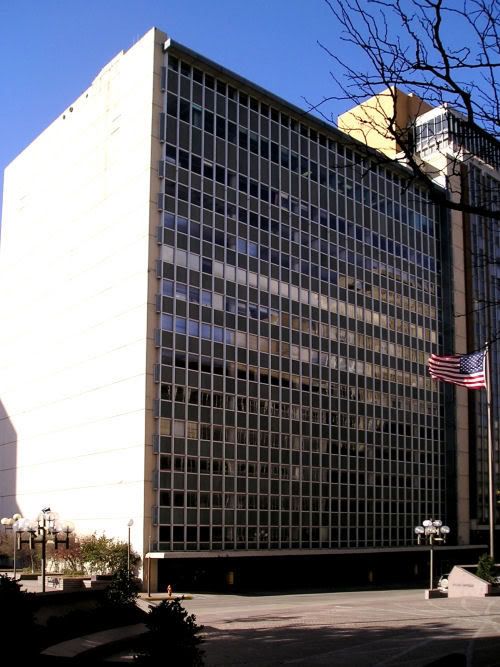
Looking West Along Couch Drive
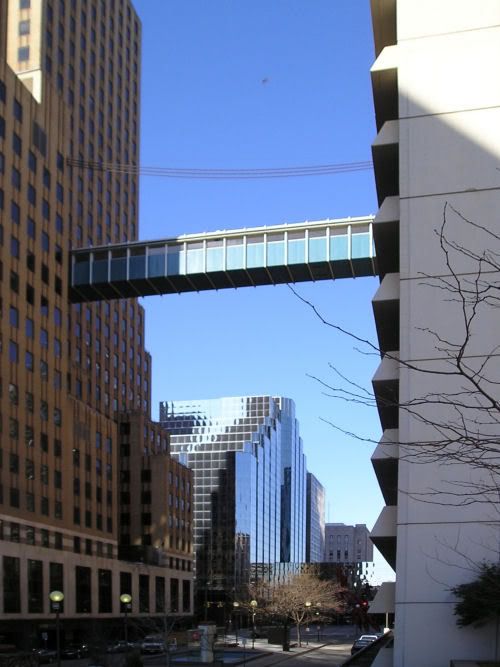
Looking Northwest From Couch Drive
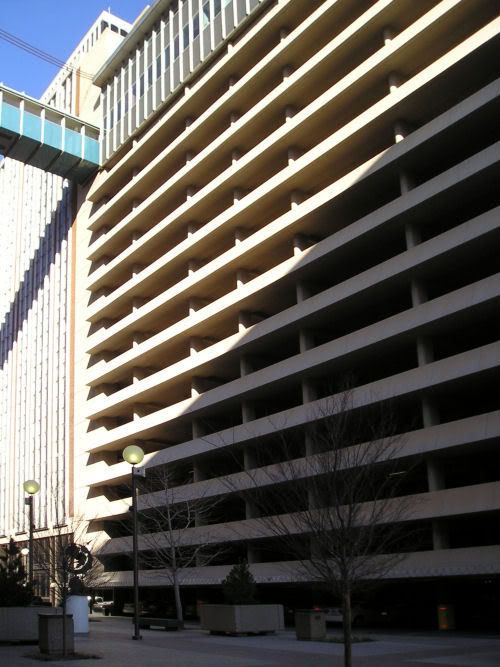
Looking Up From Couch – The 14th & 15h Floors Were The Original Petroleum Club















7 comments:
i really enjoyed this piece on the two Petroleum Club buildings. I am actually an employee of Globe Life and I can tell you that we do own the "no name building" but sadly, the top two office floors are just storage... the elevators aren't even functioning. Many tenants of the City Place building, mostly employees of various lawyer's offices and other offices in the building use the elevator parking in the old petroleum building, and I believe it is at almost full capacity with parking.
Enjoyed the piece.
Thanks, anon, for the comment and info ... even if it's sad to hear that the once glorious Petroleum Club space is relegated to the status you described.
Thanks a bunch for all your research and information... so sad that so many of our great buildings were destroyed or badly remodeled... very interesting facts tho! THANKS!
Brantley
Thanks for your comments, Brantley.
I remember dinning at the Petroleum club as a kid when Oklahoma Natural Gas had its yearly dealers appreciation dinner. All the dealers were there from the independent stores like Dick Christman, Western Auto, Otasco along with the biggies like Sears, Wards, etc. The food was top notch and exotic. They had a hired piano player. We were on good behavior as it was probably the most fancy thing we had seen as kids ever. Later dinners were not so fancy as they moved it to places like Eddy's. I remember winning a door prize for a meal for 2. I don't think I ever cashed in that prize.
This may be dated but I found http://www.dowellproperties.com/dc.html
It talks about the converted Petroleum Tower as office space. They say 400 parking spaces will be available.
Beautiful building. Interesting facts about them.
Quora Clone
Post a Comment